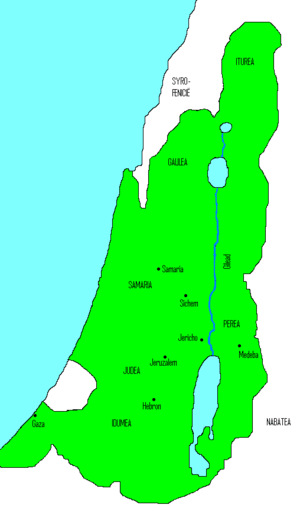Aristobulus II facts for kids
Quick facts for kids Aristobulus II |
|
|---|---|
| King and High Priest of Judaea | |

Aristobulus II, from Guillaume Rouillé's Promptuarii Iconum Insigniorum
|
|
| King of Judaea | |
| Reign | c. 66 – 63 BCE |
| Predecessor | Hyrcanus II |
| Successor | Antigonus II Mattathias |
| High Priest of Judaea | |
| Reign | c. 66 – 63 BCE |
| Predecessor | Hyrcanus II |
| Successor | Hyrcanus II |
| Died | c. 49 BCE |
| Issue | Antigonus II Mattathias Alexander of Judaea Alexandra the Hasmonean |
| Dynasty | Hasmonean |
| Father | Alexander Jannaeus |
| Mother | Salome Alexandra |
Aristobulus II was a Jewish leader who served as both the High Priest and King of Judea. He ruled from about 66 BCE to 63 BCE. He was part of the Hasmonean dynasty, a family that ruled Judea during this period.
Contents
Family and Early Life
Aristobulus was the younger son of Alexander Jannaeus, who was also a King and High Priest, and Salome Alexandra. After his father died in 76 BCE, his mother, Salome, became the ruler of Judea. She made Aristobulus's older brother, Hyrcanus II, the High Priest in 73 BCE. When Salome died in 67 BCE, Hyrcanus also became king.
Aristobulus had similar ideas to his father about religion and politics. He wanted to be king, even while his mother was still alive. He tried to get the support of important leaders and the army. He also supported the Sadducees, a religious group, and brought their concerns to the queen.
Aristobulus's Plans
The queen gave the Sadducees control of many fortresses. This was supposedly to protect them from another group called the Pharisees. However, these actions were actually part of Aristobulus's plan to take over the government. The queen tried to send him on military missions outside Judea to keep him busy.
One time, she sent him to fight against Ptolemy Mennaeus. But when that mission failed, Aristobulus went back to his political plans. He secretly left Jerusalem and went to his friends who controlled many forts. He planned to go to war against his elderly mother. Luckily for him, the queen died at that moment. He then immediately turned his attention to his brother Hyrcanus, who was the rightful heir to the throne.
The Fight for the Throne
Hyrcanus seemed to agree with the Sadducees, just like his father. Aristobulus decided to rebel against his older brother. This conflict put the Pharisees in a difficult spot.
Hyrcanus led his hired soldiers and supporters to fight Aristobulus. The brothers met in battle near Jericho. Many of Hyrcanus's soldiers switched sides and joined Aristobulus. This helped Aristobulus win the battle.
Hyrcanus found safety in the fortress of Jerusalem. But Aristobulus captured the Temple, which forced Hyrcanus to give up. They made a peace agreement. Hyrcanus agreed to give up his role as king and high priest. In return, he would still receive money from the high priest's office.
A New Alliance and Siege
This agreement did not last long. A man named Antipater the Idumaean convinced Hyrcanus that Aristobulus was planning to kill him. So, Hyrcanus went to Aretas III, the King of the Nabataeans, for help. The Nabataeans marched towards Jerusalem with a large army of 50,000 soldiers. They surrounded the city for several months during this rebellion.
Roman Involvement
During this civil war in Judea, the powerful Roman general Pompey was busy defeating other kingdoms like Pontus and the Seleucids. He sent his helper, Marcus Aemilius Scaurus, to take control of Syria.
The Hasmoneans were allies of the Romans. So, both Aristobulus and Hyrcanus asked Scaurus for help. Each brother tried to win him over with gifts and promises. Scaurus accepted a large gift of money and decided to support Aristobulus. He ordered Aretas to take his army away. As the Nabataeans retreated, Aristobulus's army attacked them and won a big victory.
Pompey's Decision
When Pompey arrived in Syria in 63 BCE, both brothers sent their representatives to him. A third group also came, asking for the entire Hasmonean family to be removed from power. Pompey took his time to decide. He preferred Hyrcanus II over Aristobulus II. He thought the older, weaker brother would be a more loyal friend to the Roman Empire.
Pompey defeated the Jewish armies in several battles. He also took control of the fortresses in Judea. Aristobulus and his sons, Alexander and Antigonus, were captured in 63 BCE. Aristobulus was suspicious of Pompey. He fortified himself in the fortress of Alexandrium. But when the Romans defeated his army again, he surrendered. He promised to hand Jerusalem over to them.
However, many of his followers did not want to open the city gates. So, the Romans attacked and captured Jerusalem by force. This caused a lot of damage to the city and the Temple. Hyrcanus was made High Priest again, but he lost his political power.
Later Rebellions and Death
Aristobulus II escaped in 57 BCE. He started another rebellion against Rome in Judea. Eventually, he was trapped by Aulus Gabinius, a Roman leader, in Machaerus. Marc Antony, a Roman cavalry commander, led his men to climb Aristobulus's defenses and defeat his forces.
Aristobulus was taken prisoner. Later, Julius Caesar released him in 49 BCE. Caesar wanted Aristobulus to turn Judea against Pompey. Aristobulus was on his way to Judea with his son Alexander. But he was poisoned by people who supported Pompey. His son Alexander was executed by the Roman commander Scipio in Antioch.
Aristobulus's other son, Antigonus, led a rebellion against Rome with help from the Parthians. He became king and high priest in 40 BCE. However, the Romans defeated and killed him in 37 BCE.
See Also
- Hasmonean coinage
- Siege of Jerusalem (disambiguation), list of sieges for, and battles of, Jerusalem


